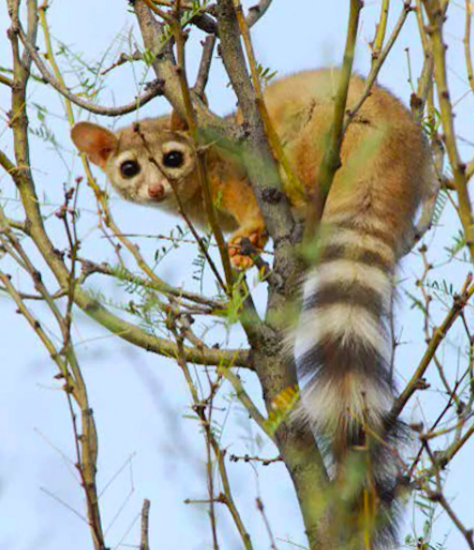Physical Description
In appearance, ring-tailed cats are similar to American mink. They have an elongated body, accompanied by relatively short limbs and a long tail. Body length ranges from 30 to 47 cm (Goldberg, n.d.). The tail is about 31-53 cm, and the weight is 0.8-1.3 kg (Goldberg, n.d.). The head is wide, with a shortened face. The ears are large, rounded, or pointy. The color of this animal is dark yellow with a black or dark brown tint. The abdomen is white, whitish, or yellowish. There are black or dark brown rings around the eyes. The tail is fluffy, with dark and light intersecting circles, like a raccoon.

Life Cycle
Newborn cubs weigh 25-30 gm, being entirely vulnerable. For the first month, they feed on maternal milk. In the second month, the eyes are opened. By the age of 3 months, cubs learn to hunt, and after another month, they leave their mother and begin to live separately. Ring-tailed cat becomes sexually mature after the age of 10 months – by that time, the breeding season begins (Buscher & Buscher, 2019). Lifespan is up to 7 years in nature, with a maximum lifespan in captivity of 19 years (Ringtail Bassariscus Astutus, n.d.).
Reproduction
The mating season begins in February and ends in May (Goldberg, n.d.). Female ringtails have only one estrous cycle during the season (Goldberg, n.d.). The heat lasts from 24 to 36 hours (Goldberg, n.d.). After mating occurs, the female searches for a place to give birth. It should be secluded and shaded, being difficult to reach by other animals. Pregnancy lasts 51 to 54 days. Cubs usually hatch from May to June. As a rule, the average offspring is three ringtails.
Structure and Function
The most interesting system of ring-tailed cats is the skeleton. The animal’s paws are short, but the ring-tailed cat uses them dexterously. The animal can climb rocks and trees, which helps in hunting. Much of this mastery is possible due to the structure of the bones of the hind legs, allowing the creature to make a 180-degree turn (Animal Fact Sheet: Ringtail, n.d.). The claws are semi-retractable (Ringtail Skull, n.d.). The skeleton itself is also capable of bending, which helps to crawl into narrow crevices. Therefore, the movements of the animal may seem unusual.
Energy Ecology
Ring-tailed cats are omnivorous but prefer protein foods. In the summer period, the animal mainly eats insects, mouse-like rodents, rabbits, and squirrels. Sometimes it catches birds, lizards, snakes, frogs, or eats carrion (Franck & Farid, 2020). Concerning plant-based food, the creature consumes acorns, juniper berries, mistletoe, persimmons, along with other affordable fruits and vegetables (Franck & Farid, 2020). After feeding, the animals thoroughly clean themselves like cats. They lick the fur and front paws, with which they then wipe their cheeks, muzzle, and ears. It is an important carnivore that helps keep the rodent population under control.
Habitat

Bassariscus astutus has adapted to life in densely populated regions. The habitat is North America in such states as California, Colorado, Oklahoma, Oregon, Arizona, Wyoming, New Mexico, Nevada, Utah, Texas, and New Mexico (Goldberg, n.d.). Small populations of ring-tailed cats exist in Louisiana and Alabama (Goldberg, n.d.). It also lives in northern and central Mexico. Concerning Mexican states, it is presented in Guerrero, Oaxaca, and Veracruz (Goldberg, n.d.). Ring-tailed cats inhabit rocky and stony areas, canyons, coniferous mountain forests, and semi-deserts (Local Species, n.d.). It prefers places near water sources up to 1400 m above sea level (Goldberg, n.d.). Thus, the mountain landscape characterizes the animals’ habitat.
Resources
Animal Fact Sheet: Ringtail (n.d.) Arizona-Sonora Desert Museum. Web.
Ashby, J. (2015). Specimen of the Week 204: The ringtail skeleton and tail skin. USL Culture. Web.
Buscher, L., & Buscher, D. (2019). Ringtail cats: Photos of the ‘cutest animal in North America’. LiveScience. Web.
Franck, A. R., & Farid, A. (2020). Many species of the Carnivora consume grass and other fibrous plant tissues. Belgian Journal of Zoology, 150, 1-70. Web.
Goldberg, J. (n.d.). Bassariscus Astutus. Animal Diversity Web.
Local Species (n.d.) The Frontera Land Alliance. Web.
Ringtail Bassariscus Astutus (n.d.) The Human Ageing Genomic Resources. Web.
Ringtail Skull (n.d.) Bone Clones. Web.